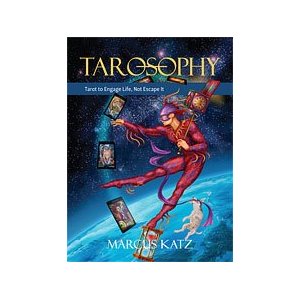This is not your average tarot book. And it certainly is no “Tarot for Dummies”.
In fact, I am going to start off by saying that this book took me a lot longer to get through than most tarot books that I own. I’m a fast reader but this one demanded that I slow down and take my time. (The only other tarot books that have affected me that way were Jodorowsky’s “The Way of the Tarot” and “Forest of Souls” by Rachel Pollack.)
Tarosophy by Marcus Katz (Salamander and Sons, ISBN 13 978-0980409932) strives to be a complete tarot book that covers exercises from beginner to advanced student with a section in the back for professionals. Packing that much into one book does run the risk of being a “jack of all trades, master of none” but the author manages to put together a pretty good book.
The beginner’s section starts out with basic information such as how to choose your deck, preparing to read, an intro to Kabbalah (a simple but effective technique brings this home beautifully), archetypes, spreads and more. Just this section alone would have merited one book in itself but the author manages to get all this information in and make it digestible.
The intermediate and advanced section is where the average tarot reader may feel a bit lost. Here, the author delves into some pretty heavy stuff – from a 7 day ritual, to triads, 3D spreads, meditations, the natal chart, NLP techniques, deeper Kabbalah and more. This is not for lightweights. And some of the techniques presented may not be of interest for every tarot reader either. (For example, I would not be interested in doing a Thoth based ritual – but fans of that deck may be enthusiastic for something of that nature.)
I was impressed with some of the unique exercises presented in the book. In fact, a few worked very well (Living the Archetypes, generating your own keywords, Inner Guide meditation, merging the cards, and the fun Haiku method!). Tarot readers who are hungry for innovative exercises will love that part.
Many chapters finish with suggested reading lists that may encourage the reader to go even deeper in their tarot studies. The book is rigorously researched with scrupulous footnotes throughout – it’s obvious that the author put a lot of effort (and love) into making sure that no stone was left unturned in this book.
I was especially fond of the appendix in the back geared towards tarot professionals – here the author shines brightly with a chapter titled “Half Your Market Think That You Are Evil”. The information presented is solid and generously full of practical advice that will be of good use for any tarot pro. There is also a section on Tarot Law but this is written for a United Kingdom audience (the author is British). (If you are looking for legal advice for your country, you will need to consult your own lawyer to be sure you are following the proper legal guidelines.)
A fun but pragmatic “Top Tarot Tweet Tips” finishes off the book with sensible tidbits of wisdom that all readers will appreciate (my favorite: small glass picture pebbles to hold down your cards when reading outdoors!).
Some people may be put off by the overall tone of the book, which leans towards dry and scholarly. Also, if you are looking for a basic book that will give you the meanings of the cards with simple spreads, this is not the book for you. If you are a practical reader with an interest in common sense advice applications of tarot, this book won’t be for you either. “Tarosophy” is best suited for the serious tarot student with an esoteric mindset.
Although this book may not be a general tarot guide, it WILL make you a better tarot reader if you are willing to plug away. It’s not an easy read but for those who need a tarot challenge, this is the one you’ve been waiting for.
I am giving this book a hesitant 2 Swords up because it will not appeal to every reader.
Blessings!
Theresa


 I’m Theresa Reed (aka, The Tarot Lady). I’ve been a full-time tarot reader for 30+ years — which, in my industry, makes me pretty badass.
I’m definitely not your average Tarot expert — I drop the F-bomb, I quote rappers, and I’m obsessed with pop culture + reality TV. Folks come to me for straight-talk + tough-love — without the woo-woo fluff.
I’m Theresa Reed (aka, The Tarot Lady). I’ve been a full-time tarot reader for 30+ years — which, in my industry, makes me pretty badass.
I’m definitely not your average Tarot expert — I drop the F-bomb, I quote rappers, and I’m obsessed with pop culture + reality TV. Folks come to me for straight-talk + tough-love — without the woo-woo fluff.
You must be logged in to post a comment.